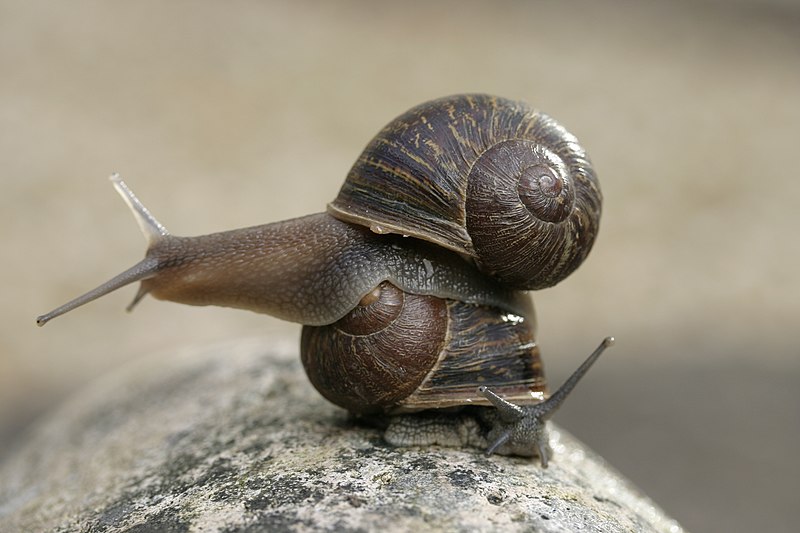The Kids Are All Right

Pictured above are two garden snails. The one on top is named Jeremy; the one on the bottom isn’t special enough to warrant a human name. What makes Jeremy special? Take a look at his shell. You’ll note that the coil on Jeremy’s shell is on his left; the coil on the bottom snail is on its right.
And if you’re a snail, that’s not a good thing. Left-coiling snails, formally known as “sinistra snails,” are rare — by conservative estimates, only one in 100,000 garden snails have shells that coil to their left, and that number may be as high as one in a million. But in this case, being one in a million doesn’t make Jeremy very popular. When it comes to a snail’s anatomy, shell placement matters — and, in particular, it impacts the snails’ reproductive systems. As Angus Davidson, one of the researchers who studied Jeremy, explained in The Conversation, “lthough garden snails, Cornu aspersum, are hermaphrodite (both sexes at the same time), they prefer to mate with other snails. But Jeremy had not only a reverse-coiled shell but also genitals on the opposite side of the body to normal, making it very difficult [which is to say, practically impossible] to mate with most other snails.”
Normally, the mating habits of a garden snail wouldn’t be a big deal, but Davidson, a snail expert, was intrigued. Using the power of the media and the Internet, he set out to find Jeremy a mate. The BBC took up the mantle and put out the call in October 2016, asking readers who come across a lefty snail to email the broadcaster or “reach us on social using the hashtag #snaillove.” And their collective efforts proved successful. A month later, per NPR, snail fans around the world offered up not one but two potential mates — Lefty, someone’s pet snail, also a UK resident; and Tomeu, a sinistra from Majorica, Spain. (Tomeu’s left-coiledness likely saved it from a not-great fate; as NPR reported, it was “found by a snail farmer who runs a restaurant that specializes in — you guessed it — snails.”)
Initially for Jeremy, it seemed that two mates turned out to not be better than one. Per a May 2017 report from the BBC, “instead of mating with Jeremy, the two ‘lefty’ snails decided to mate with each other,” producing 170 offspring. (Snails give birth to more than one baby snail at a time, in case you were wondering.) Garden snails have a lifespan in captivity of only a couple of years, and Jeremy’s time was running out.
But just days before Jeremy’s death in October of 2017, Tomeu produced 56 more offspring. According to Davidson, it’s almost certain that Jeremy “fathered” some of them; as he said in The Conversation, about one-third likely came from the celebrity snail. While Jeremy never got to meet his snail babies, that’s not a major loss; as Davidson told the New York Times, “on a scientific note, he wouldn’t have recognized [them].”
And speaking of science, there was something interesting that Davidson and team learned from this effort to find Jeremy a match: lefty snails don’t necessarily — or even typically — make lefty snail kids. Of the more than 200 snails bred from this “experiment,” all of them were righties. (As the title above suggests, The Who would approve.)
Jeremy’s legacy — and the effort to better understand where sinistra snails come from — continues. As CNN reported in 2020, the search for Jeremy’s mate ultimate resulted in a bounty of lefties discovered: “a keen-eyed group of citizen scientists and farmers found more than 40 lefty snails in the wild and on snail farms in America, Australia and Europe,” and Davidson and team have been breeding them ever since. One neat finding suggests the genetic factor may skip a generation: “When coauthor and citizen scientist Philippe Thomas mated second-generation dextral [right-coiled] offspring of French sinistral garden snails. Six of 32 dextral snails produced 17 sinistral offspring out of 6,302 total offspring. The proportion of sinistrals in the righty snails that produced any sinistrals at all was 1.7%.”
Bonus fact: Another snail mystery comes from the Middle Ages. As Smithsonian reports, “it’s common to find, in the blank spaces of 13th and 14th century English texts, sketches and notes from medieval readers. And scattered through this marginalia is an oddly recurring scene: a brave knight in shining armor facing down a snail.” Seems strange — and to date, there’s no agreed-upon explanation why someone would want to depict a knight fighting a snail. But one thing is for sure: the drawings are not very scientifically accurate, as the snails are not only out of scale (compared to the knight), but also, many of them coil to the left.
From the Archives: Coming Alive at a Snail’s Pace: A dead snail says hello.
